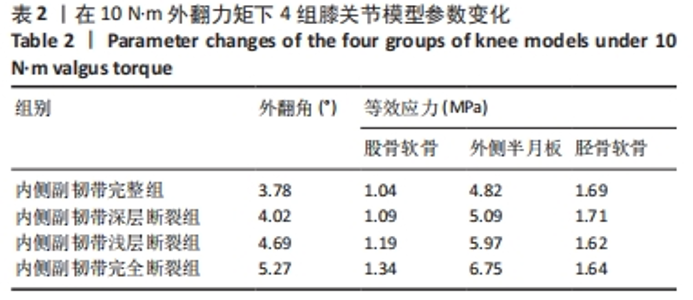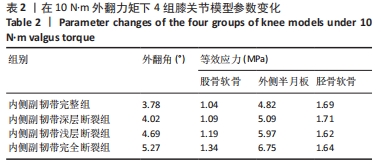Chinese Journal of Tissue Engineering Research ›› 2024, Vol. 28 ›› Issue (33): 5270-5275.doi: 10.12307/2024.660
Previous Articles Next Articles
Stress changes of knee joint with different degrees of medial collateral ligament injury
Jiang Yaqiong1, Lu Tan1, Xu Biao1, Yang Junliang1, Yin Yujiao2
- 1Ward One, Department of Joint and Trauma Surgery, Xinxiang Key Laboratory of Degenerative Bone and Joint Diseases, 2First Department of Surgery, First Affiliated Hospital of Xinxiang Medical University, Weihui 453100, Henan Province, China
-
Received:2023-08-10Accepted:2023-10-12Online:2024-11-28Published:2024-01-30 -
Contact:Lu Tan, Associate chief physician, Ward One, Department of Joint and Trauma Surgery, Xinxiang Key Laboratory of Degenerative Bone and Joint Diseases, First Affiliated Hospital of Xinxiang Medical University, Weihui 453100, Henan Province, China -
About author:Jiang Yaqiong, Master candidate, Physician, Ward One, Department of Joint and Trauma Surgery, Xinxiang Key Laboratory of Degenerative Bone and Joint Diseases, First Affiliated Hospital of Xinxiang Medical University, Weihui 453100, Henan Province, China -
Supported by:Medical Science and Technology Research Program of Henan Province (Joint Co-construction), No. LHGJ20190450 (to LT)
CLC Number:
Cite this article
Jiang Yaqiong, Lu Tan, Xu Biao, Yang Junliang, Yin Yujiao. Stress changes of knee joint with different degrees of medial collateral ligament injury[J]. Chinese Journal of Tissue Engineering Research, 2024, 28(33): 5270-5275.
share this article
Add to citation manager EndNote|Reference Manager|ProCite|BibTeX|RefWorks

通过Ansys软件对4组膝关节模型施加3种不同模式载荷,模拟膝关节伸直位受力情况,从而进行半月板、股骨软骨及胫骨软骨等效应力峰值的计算,并得出应力云图。 2.1 在10 N·m外翻载荷下膝关节半月板和软骨的应力变化 基于膝关节10 N·m外翻力矩,正常膝关节外侧半月板受力较大,并且应力集中于外侧半月板前角,股骨、胫骨软骨应力峰值出现于外侧软骨前角位置,膝关节外翻角约3.78°;MCL损伤后,股骨、胫骨软骨及半月板应力峰值均有所增加,而应力变化主要集中于半月板,分布上,股骨及胫骨软骨最大应力分布于外侧部位,半月板主要分布于外侧前后角位置,见图3。DMCL断裂后股骨软骨、外侧半月板和胫骨软骨最大应力分别为 1.09,5.09,1.71 MPa;SMCL断裂后股骨软骨、外侧半月板和胫骨软骨最大应力分别为 1.19,5.97,1.62 MPa;MCL完全断裂后股骨软骨、外侧半月板和胫骨软骨最大应力分别为1.34,6.75,1.64 MPa,见图4。 外翻角在DMCL断裂组、SMCL断裂组和MCL完全断裂组变为4.02°,4.69°,5.27°,见表2。"
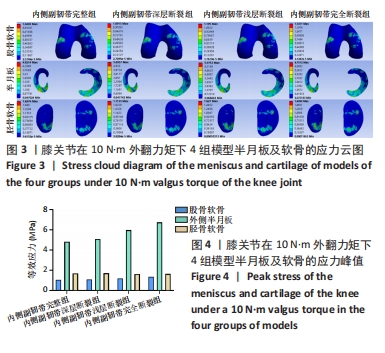

2.2 在4 N·m内旋载荷下膝关节半月板和软骨的应力变化 基于膝关节4 N·m内旋扭矩,正常膝关节股骨、胫骨软骨应力峰值出现于内侧软骨前后角位置,半月板应力峰值出现于内侧后角,股骨软骨、内外侧半月板和胫骨软骨最大应力分别为 0.86,3.88,3.52和1.32 MPa;DMCL断裂时,膝关节半月板和软骨应力分布无明显变化,但应力均有所增加,股骨软骨、内外侧半月板和胫骨软骨最大应力分别为 0.90,3.68,4.06和1.37 MPa;SMCL断裂后,膝关节软骨应力分布无明显改变,半月板应力峰值出现在外侧半月板前角,股骨软骨、内外侧半月板和胫骨软骨最大应力分别为 1.10,4.22,4.38和1.65 MPa;MCL完全断裂后,膝关节股骨、胫骨软骨应力峰值出现于内侧软骨前角位置,半月板应力峰值出现于外侧前角,股骨软骨、内外侧半月板和胫骨软骨最大应力分别为1.18,4.45,4.65和1.73 MPa,见图5,6。股骨内旋角从完整MCL的2.61°变为DMCL断裂、SMCL断裂和MCL完全断裂的2.85°,3.07°,3.21°,见表3。"
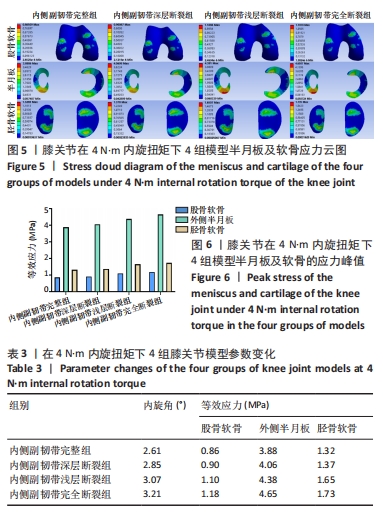

2.3 在4 N·m外旋载荷下膝关节半月板和软骨的应力变化 基于膝关节4 N·m外旋扭矩,正常膝关节股骨、胫骨软骨应力峰值出现于外侧软骨前角位置,半月板应力峰值出现于外侧前角,股骨软骨、内外侧半月板和胫骨软骨最大应力分别为 0.65,2.83,3.06和1.02 MPa。随着MCL损伤程度加重,股骨、胫骨软骨及内外侧半月板应力呈现渐增的趋势,分布上,股骨及胫骨软骨最大应力分布于外侧部位,内外侧半月板应力均主要分布于前后角位置。DMCL断裂时,股骨软骨、内外侧半月板和胫骨软骨最大应力分别为 0.68,2.93,3.16和1.05 MPa;SMCL断裂后股骨软骨、内外侧半月板和胫骨软骨最大应力分别为 0.90,3.27,3.91和1.30 MPa;MCL完全断裂后股骨软骨、外侧半月板和胫骨软骨最大应力分别为0.97,3.42,4.21和1.37 MPa,见图7,8。股骨外旋角从完整MCL的2.20°变为DMCL断裂、SMCL断裂和MCL完全断裂的2.38°,2.45°,2.81°,见表4。"
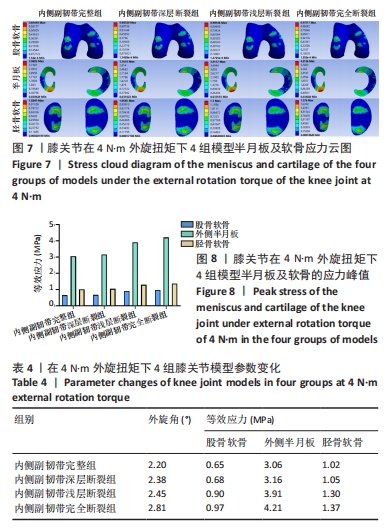
| [1] WIJDICKS CA, GRIFFITH CJ, JOHANSEN S, et al. Injuries to the Medial Collateral Ligament and Associated Medial Structures of the Knee. J Bone Joint Surg Am. 2010;92(5):1266-1280. [2] 王海鹏, 王友, 容可, 等. 三维有限元法分析膝关节内侧副韧带的生物力学功能[J]. 医用生物力学,2012,27(1):40-45. [3] MANCINI EJ, KOHEN R, ESQUIVEL AO, et al. Comparison of ACL Strain in the MCL-Deficient and MCL-Reconstructed Knee During Simulated Landing in a Cadaveric Model. Am J Sports Med. 2017;45(5):1090-1094. [4] LAPRADE RF, ROBERT F. The Anatomy of the Medial Part of the Knee. J Bone Joint Surg Am. 2007;89(9):2000-2010. [5] BOLLEN S. Epidemiology of knee injuries: Diagnosis and triage. Br J Sports Med. 2000;34(3):227-228. [6] 张盼盼. 内侧副韧带断裂损伤对人体自然及TKA后膝关节屈曲运动影响的仿真分析[D]. 焦作:河南理工大学,2017. [7] REN D, LIU Y, ZHANG X, et al. The evaluation of the role of medial collateral ligament maintaining knee stability by a finite element analysis. J Orthop Surg Res. 2017;12(1):1-10. [8] BATTAGLIA MJ, LENHOFF MW, EHTESHAMI JR, et al. Medial collateral ligament injuries and subsequent load on the anterior cruciate ligament: a biomechanical evaluation in a cadaveric model. Am J Sports Med. 2009;37(2):305-311. [9] SHEKARFOROUSH M, BEVERIDGE JE, HART PA, et al. Correlation between translational and rotational kinematic abnormalities and osteoarthritis-like damage in two in vivo sheep injury models. J Biomech. 2018;75:67-76. [10] GARDINER JC, WEISS JA. Subject-specific finite element analysis of the human medial collateral ligament during valgus knee loading. J Orthop Res. 2010;21(6):1098-1106. [11] 黄荣瑛, 郑红光, 徐强, 等. MCL缺损对多屈曲角胫股关节力学特性影响[J]. 工程力学,2012,29(7):298-304. [12] 黄勇, 常崇斐, 苏帆, 等. 膝关节内侧副韧带损伤后对前交叉韧带生物力学的影响[J]. 深圳中西医结合杂志,2020,30(1):194-196. [13] WILLINGER L, BALENDRA G, PAI V, et al. Medial meniscal ramp lesions in ACL-injured elite athletes are strongly associated with medial collateral ligament injuries and medial tibial bone bruising on MRI. Knee Surg Sports Traumatol Arthrosc. 2022;30(5):1502-1510. [14] 邵嘉艺, 张家豪, 任爽, 等. 膝关节内侧副韧带浅层(sMCL)止点的解剖学及有限元分析[J]. 中国运动医学杂志,2020,39(2):93-96. [15] GEESLIN AG, LAPRADE RF. Location of Bone Bruises and Other Osseous Injuries Associated With Acute Grade III Isolated and Combined Posterolateral Knee Injuries. Am J Sports Med. 2010;38(12):2502-2508. [16] 何川, 李彦林, 张振光, 等. 不同屈曲状态下膝关节韧带生物力学的有限元分析[J]. 中国运动医学杂志,2015,34(7):662-669. [17] WIERER G, MILINKOVIC D, ROBINSON JR, et al. The superficial medial collateral ligament is the major restraint to anteromedial instability of the knee. Knee Surg Sports Traumatol Arthrosc. 2021;29(2):405-416. [18] BUCKTHORPE M, PISONI D, T0SARELLI F, et al. Three Main Mechanisms Characterize Medial Collateral Ligament Injuries in Professional Male Soccer-Blow to the Knee, Contact to the Leg or Foot, and Sliding: Video Analysis of 37 Consecutive Injuries. J Orthop Sports Phys Ther. 2021;51(12):611-618. [19] SIM JA, NA YG, CHOI JW, et al. Early medial reconstruction combined with severely injured medial collateral ligaments can decrease residual medial laxity in anterior cruciate ligament reconstruction. Arch Orthop Trauma Surg. 2022;142(10):2791-2799. [20] MIYAJI N, HOLTHOF SR, BALL SV, et al. Medial Collateral Ligament Reconstruction for Anteromedial Instability of the Knee: A Biomechanical Study In Vitro. Am J Sports Med. 2022;50(7):1823-1831. [21] HINTERWIMMER S, BAUMGART R, PLITZ W. Tension changes in the collateral ligaments of a cruciate ligament-deficient knee joint: an experimental biomechanical study. Arch Orthop Trauma Surg. 2002;122(8):454-458. [22] BREKELMANS WA, POORT HW, SLOOFF TJ. A new method to analyse the mechanical behaviour of skeletal parts. Acta Orthop Scand. 1972;43(5):301-317. [23] NEWCOMB AG, BAEK S, KELLY BP, et al. Effect of screw position on load transfer in lumbar pedicle screws: a non-idealized finite element analysis. Comput Methods Biomech Biomed Engin. 2017;20(2):182-192. [24] CHEN YF, LU C, ZHAO Y, et al. Construction and simulation mechanical analysis of dynamic knee joint finite element model based on CT image. Zhongguo Gu Shang. 2020;33(5):479-484. [25] JOGI SP, THAHA R, RAJAN S, et al. Model for in-vivo estimation of stiffness of tibiofemoral joint using MR imaging and FEM analysis. J Transl Med. 2021;19(1):310. [26] 王俊然, 杜玮瑾, 王长江, 等. 有限元分析不同屈曲状态下胫-股关节的生物力学变化[J]. 中国组织工程研究,2018,22(31):4975-4981. [27] 杭声琪, 张文韬, 王泰淇, 等. 基于CT和MRI膝关节有限元模型建立与不同载荷下生物力学特性分析[J]. 中国医学物理学杂志,2021,38(3):370-374. [28] HWANG SH, JUNG KA, LEE WJ, et al. Morphological changes of the lateral meniscus in end-stage lateral compartment osteoarthritis of the knee. Osteoarthritis Cartilage. 2012;20(2):110-116. [29] 郑明, 林凤飞, 肖莉莉,等. 膝内、外翻畸形对膝关节影响的三维有限元计算分析[J]. 骨与关节损伤杂志,2004,19(3):174-176. [30] 单云官, 王连鹏, 张金波,等. 股胫关节面的形态与扣锁机制的解剖学基础[J]. 中国临床解剖学杂志,2007,25(6):650-652+655. [31] 黄振宇, 董跃福, 胡广洪, 等. 基于有限元方法的正常和早期OA膝关节生物力学行为比较[J]. 中国数字医学,2015,10(5):6-9. [32] BALL S, STEPHEN JM, EL-DAOU H, et al. The medial ligaments and the ACL restrain anteromedial laxity of the knee. Knee Surg Sports Traumatol Arthrosc. 2020;28(12):3700-3708. [33] 吴铮,任静,万建杉,等. 步态周期下半月板损伤对膝关节生物力学性能的影响[J]. 中国组织工程研究,2020,24(21):3299-3303. [34] CAVAIGNAC E, CARPENTIER K, PAILHÉ R, et al. The role of the deep medial collateral ligament in controlling rotational stability of the knee. Knee Surg Sports Traumatol Arthrosc. 2015;23(10):3101-3107. [35] WHITTAKER JL, LOSCIALE JM, JUHL CB, et al. Risk factors for knee osteoarthritis after traumatic knee injury: a systematic review and meta-analysis of randomised controlled trials and cohort studies for the OPTIKNEE Consensus. Br J Sports Med. 2022;56(24):1406-1421. [36] BLACK AK, SCHLEPP C, ZAPF M, et al. Technique for Arthroscopically Assisted Superficial and Deep Medial Collateral Ligament-Meniscotibial Ligament Repair With Internal Brace Augmentation. Arthrosc Tech. 2018;7(11):e1215-e1219. [37] WILLIAMS A, BECKER R, AMIS A. The medial collateral ligament: the neglected ligament. Knee Surg Sports Traumatol Arthrosc. 2020;28(12):3698-3699. [38] IIZAWA N, MORI A, MAJIMA T, et al. Influence of the Medial Knee Structures on Valgus and Rotatory Stability in Total Knee Arthroplasty. J Arthroplasty. 2016;31(3):688-693. |
| [1] | Li Zhifei, Yang Yin, Chen Hualong, Liang Qinqiu, Zhong Yuanming, Zhang Yisheng. Finite element analysis of the correlation between tilt angle of titanium cage and postoperative subsidence of titanium cage after anterior subtotal cervical corpectomy, decompression and fusion [J]. Chinese Journal of Tissue Engineering Research, 2024, 28(9): 1313-1319. |
| [2] | Chen Mengmeng, Bao Li, Chen Hao, Jia Pu, Feng Fei, Shi Guan, Tang Hai. Biomechanical characteristics of a novel interspinous distraction fusion device BacFuse for the repair of lumbar degenerative disease [J]. Chinese Journal of Tissue Engineering Research, 2024, 28(9): 1325-1329. |
| [3] | Liang Cheng, Zhang Linqi, Wang Guan, Li Wen, Duan Ke, Li Zhong, Lu Xiaobo, Zhuo Naiqiang. Finite element and biomechanical analysis of different implants in repair for unilateral unstable pelvic posterior ring injury [J]. Chinese Journal of Tissue Engineering Research, 2024, 28(9): 1336-1341. |
| [4] | Yang Junliang, Lu Tan, Xu Biao, Jiang Yaqiong, Wang Fucheng. Three-dimensional finite element analysis of effects of partial anterior cruciate ligament rupture on knee joint stress [J]. Chinese Journal of Tissue Engineering Research, 2024, 28(9): 1347-1353. |
| [5] | Li Yongjie, Fu Shenyu, Xia Yuan, Zhang Dakuan, Liu Hongju. Correlation of knee extensor muscle strength and spatiotemporal gait parameters with peak knee flexion/adduction moment in female patients with knee osteoarthritis [J]. Chinese Journal of Tissue Engineering Research, 2024, 28(9): 1354-1358. |
| [6] | Li Chaojie, Gulati•Maitirouzi, Aierxiding•Abulaiti, Zheng Hui, Tu Hudi. Finite element analysis of medial patellofemoral ligament reconstruction at different flexion angles [J]. Chinese Journal of Tissue Engineering Research, 2024, 28(9): 1359-1364. |
| [7] | Weng Rui, Lin Dongxin, Guo Haiwei, Zhang Wensheng, Song Yuke, Lin Hongheng, Li Wenchao, Ye Linqiang. Abnormal types of intervertebral disc structure and related mechanical loading with biomechanical factors [J]. Chinese Journal of Tissue Engineering Research, 2024, 28(9): 1436-1442. |
| [8] | Xiaheida·Yilaerjiang, Nijiati·Tuerxun, Reyila·Kuerban, Baibujiafu·Yelisi, Chen Xin. Three-dimensional finite element analysis of the distribution pattern of stress in bone tissues with different characteristics [J]. Chinese Journal of Tissue Engineering Research, 2024, 28(8): 1277-1282. |
| [9] | Wang Qiang, Li Shiyun, Xiong Ying, Li Tiantian. Biomechanical changes of the cervical spine in internal fixation with different anterior cervical interbody fusion systems [J]. Chinese Journal of Tissue Engineering Research, 2024, 28(6): 821-826. |
| [10] | Wei Yuanbiao, Lin Zhan, Chen Yanmei, Yang Tenghui, Zhao Xiao, Chen Yangsheng, Zhou Yanhui, Yang Minchao, Huang Feiqi. Finite element analysis of effects of sagittal cervical manipulation on intervertebral disc and facet joints [J]. Chinese Journal of Tissue Engineering Research, 2024, 28(6): 827-832. |
| [11] | Zhang Rui, Wang Kun, Shen Zicong, Mao Lu, Wu Xiaotao. Effects of endoscopic foraminoplasty and laminoplasty on biomechanical properties of intervertebral disc and isthmus [J]. Chinese Journal of Tissue Engineering Research, 2024, 28(6): 833-839. |
| [12] | Kang Zhijie, Cao Zhenhua, Xu Yangyang, Zhang Yunfeng, Jin Feng, Su Baoke, Wang Lidong, Tong Ling, Liu Qinghua, Fang Yuan, Sha Lirong, Liang Liang, Li Mengmeng, Du Yifei, Lin Lin, Wang Haiyan, Li Xiaohe, Li Zhijun. Finite element model establishment and stress analysis of lumbar-sacral intervertebral disc in ankylosing spondylitis [J]. Chinese Journal of Tissue Engineering Research, 2024, 28(6): 840-846. |
| [13] | Zhang Min, Peng Jing, Zhang Qiang, Chen Dewang. Mechanical properties of L3/4 laminar decompression and intervertebral fusion in elderly osteoporosis patients analyzed by finite element method [J]. Chinese Journal of Tissue Engineering Research, 2024, 28(6): 847-851. |
| [14] | Xue Xiaofeng, Wei Yongkang, Qiao Xiaohong, Du Yuyong, Niu Jianjun, Ren Lixin, Yang Huifeng, Zhang Zhimin, Guo Yuan, Chen Weiyi. Finite element analysis of osteoporosis in proximal femur after cannulated screw fixation for femoral neck fracture [J]. Chinese Journal of Tissue Engineering Research, 2024, 28(6): 862-867. |
| [15] | Huang Peizhen, Dong Hang, Cai Qunbin, Lin Ziling, Huang Feng. Finite element analysis of anterograde and retrograde intramedullary nail for different areas of femoral shaft fractures [J]. Chinese Journal of Tissue Engineering Research, 2024, 28(6): 868-872. |
| Viewed | ||||||
|
Full text |
|
|||||
|
Abstract |
|
|||||
